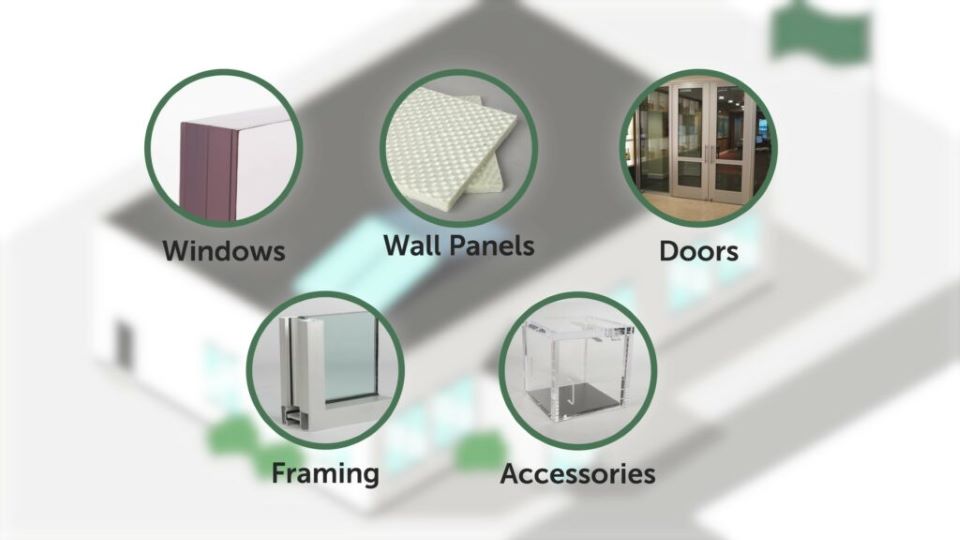Making the Case for a Systems Approach to Ballistic Security

In Bullet-Resistant Systems, Key Components Come Together to Build Something Greater

For those unfamiliar with ballistic security, it would be easy to assume the process is as simple as a single piece of bullet-resistant glass. The terms themselves – “ballistic”, “bulletproof” and “bullet-resistant” – tend to inspire confidence, and the average person may not be aware of the various components of a ballistic barrier system.
Unfortunately, no single ballistic item can provide adequate protection on its own. A cohesive system is needed to protect people and property. This systems approach can be achieved using various bullet-resistant materials.
What Are the Components of a Bullet-Resistant System?
Major components of a ballistic barrier system include glazing, wall panels, doors, framing and accessories like deal trays or package passers. Let’s briefly walk through each.
- Glazing: Bullet-resistant glass is usually made of acrylic or polycarbonate and can be used for exterior or interior applications. Additional considerations include protection level (many products on the market have a UL rating), light transmission, durability and energy efficiency.
- Doors: Common materials for bullet-resistant doors include aluminum, wood, acrylic and steel. Many organizations opt for doors that match the surrounding aesthetic with windows, framing and hardware to help it “blend in.”
- Framing: Doors, windows and other points of entry are the inherent weak spots in a security system. In general, systems rated UL level 3 and up should also incorporate rated framing.
- Wall Panels: While windows and doors are often the primary focus for physical security upgrades, standard construction drywall will not stop bullets. Ballistic paneling (usually made from fiberglass) helps protect anyone taking shelter behind a counter or in a locked room.
- Accessories: A ballistic system shouldn’t impede the day-to-day operation of the building. Accessories like voice ports, recessed deal trays and package passers help staff complete tasks and facilitate communication between employees and visitors.
The most critical aspect of a ballistic barrier system is that it is designed to meet the specific needs of its environment. Individual components will be determined by the perceived threat level, required protection level and budget. For example, a rural municipal office will have different security concerns than a downtown corporate office. A systems approach will mean designing the system for the space – not buying a one-off product or two.

What Does a “Systems” Approach Look Like?
I’ve mentioned how an individual bullet-resistant window can’t provide adequate protection on its own, but what does this cohesive system actually look like? How do “products” like doors and windows come together to protect people and property?
Let’s walk through an example of what a ballistic system might look like and how the various components come together to build something greater.
Imagine a municipal building in a midsized city (population 150,000-500,000). The local government takes ballistic security seriously and wants to ensure they protect staff, visitors and property while also responsibly investing their time and money in the right places.
The exterior will likely feature ground floor windows fitted with UL level 3 ballistic glazing (although levels 4 to 5 are also becoming more common). Second-story windows do not always need a ballistic rating but should be considered depending on the perceived threat level.
Exterior doors should match the UL level of the windows and blend in with the surrounding aesthetic of the building. An unobtrusive design will help staff and visitors feel more comfortable in the space and not like they’re walking into a bunker.
The entryway may have a second set of matching bullet-resistant doors that form a secure vestibule. After entering the exterior door, employees and visitors must complete a secondary action (using an electronic card reader or having credentials checked by a staff member).
The lobby might feature a security booth or help desk. Panes of ballistic glass give a clear line of visibility and enable easy interactions with the public. The area below the counter is reinforced with ballistic panels to protect anyone who may need to take shelter behind the booth.
Other areas accessible by the public might include the clerk’s counter or treasurer’s window. Ballistic transaction windows and below counter paneling protect employees while recessed deal trays, voice ports and package passers make it simple to pass documents back and forth and interact with visitors.
Back offices and workstations can also be protected. An executive office might feature a UL level 3 or 4 wooden door, fiberglass panels within the walls and a ballistic-rated window. It’s not always feasible to protect every workstation, and many organizations retrofit a conference room as a safe room. With ballistically rated, doors, windows and walls, a safe room doubles as a functioning conference room and a place for staff to gather during a security incident.
This hypothetical example can be adapted to other industries. When planning physical security measures, it’s essential to think through the needs of the people using the building and how to design a barrier that accommodates day-to-day operations. For example:
- A school will usually have a front desk to check visitors in and out.
- A convenience store will need to accommodate passing payments and larger items between employees and customers.
- A bank or credit union needs to communicate with members, pass documents back and forth or accommodate a drive-through.
Bullet-Resistant Barriers as Part of the Security Ecosystem
The security industry has grown and developed a lot over the past decade. As security professionals, we must consider how a barrier system will fit into the larger security ecosystem. Will it hinder or enhance other measures like access control, alarms, cybersecurity, identity management, information technology, life safety, perimeter security or video surveillance?
Taking a systems approach will help us better understand how individual components fit together and form a comprehensive framework to better protect both people and property.
Jim Richards is the CEO of Total Security Solutions.
